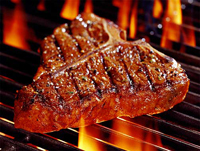BODYBUILDING
EXERCISING SCHEDULE :
Two Body Parts
A Day , Twice A Week
Monday: Chest and
triceps
Chest:
1. Incline
dumbbell press-
4 sets of 15,
12, 10, 8 reps.
2. Flatbench
barbell press-
4 sets of 12,
10, 10, 8 reps.
3. Incline
dumbbell flies-
3 sets of 12,
10, 8 reps.
4. Cable
crossovers-
2 sets of 15,
12 reps.
Triceps:
1.
Pushdowns-
4 sets of 15,
12, 10, 8 reps.
2. Bent-over
cable extensions using a rope-
3 sets of 15,
12, 10 reps.
3. Dumbbell
kickbacks-
3 sets of 15,
12, 10 reps.
Tuesday: Back
and biceps
Back:
1. Lat machine
pulldowns to the front-
4 sets of 15,
12, 10, 8 reps.
2. Close grip
pulldowns to the front-
4 sets of 15,
12, 10, 8 reps.
3. Seated cable
rows-
4 sets of 15,
12, 10, 8 reps.
4.
Hyper-extensions-
3 sets of 18,
18, 18 reps.
Biceps:
1. Incline
dumbbell curls-
4 sets of 15,
12, 12, 10 reps.
2. Standing
barbell curls-
4 sets of 15,
10, 8, 6 reps.
Wednesday:
Cardio and abs
Cardio:
1. 30-45 min.
of bike, treadmill or Stairmaster.
Abs:
1.
Crunches-
3 sets of 50,
50, 50 reps.
2. Leg raises-
3 sets of 25,
20, 20 reps.
Thursday:
Legs
1.
Squats-
5 sets of 15,
15, 12, 10, 8 reps.
2. Leg
extensions-
4 sets of 15,
12, 12, 10 reps.
3.
Lunges-
4 sets of 15,
12, 10, 10 reps.
4. Leg curls
for hamstrings-
4 sets of 15,
12, 12, 10 reps.
5. Standing
calf raises-
4 sets of 18,
18, 15, 12 reps.
Friday:
Shoulders/biceps
or triceps
superset
Shoulders:
1. (Military)
barbell press behind the neck-
4 sets of 15,
12, 10, 8 reps.
2. Standing
side laterals-
4 sets of 15,
12, 12, 10 reps.
3. Upright rows
with barbell-
3 sets of 12,
12, 10 reps.
4. Seated bent
over dumbbell laterals-
4 sets of 15,
15, 12, 12 reps.
Biceps or
triceps superset:
1. Tricep
pushdowns on cable machine superset
with barbell
curls-
4 sets of 15,
12, 12, 10 reps.
2. Seated
dumbbell extension superset with
dumbbell hammer
curls-
3 sets of 15,
12, 2, 10 reps
BEST
BODYBUILDING / EXERCISING DIET PLAN
This plan
requires that you eat a high protein, high fat, low carbohydrate
diet for 5 and a half days. Then for 36
hours you carb-up. The high protein, high fat part of the
diet is what sparks the increase in blood serum levels
of:
- Testosterone
- Growth
Hormone
- IGF-1 (insulin-like growth
hormone production is stimulated by growth
hormone).
Fat
Adaptation
 As you will be keeping your
carbohydrate level low for most of the week, your body will become
a fat-burning machine. At the beginning of the diet your body will
undergo a ‘metabolic shift’ and start to burn fat as its primary
source of energy. This can take as little as 2 days and up to 14
days for some people. However, the vast majority of you will have
become fat-adapted by the end of your first 5 and a half
days.
As you will be keeping your
carbohydrate level low for most of the week, your body will become
a fat-burning machine. At the beginning of the diet your body will
undergo a ‘metabolic shift’ and start to burn fat as its primary
source of energy. This can take as little as 2 days and up to 14
days for some people. However, the vast majority of you will have
become fat-adapted by the end of your first 5 and a half
days.
The
advantages of this are:
- Increased
Lipolysis (breakdown of fat)
- Decreased
Lipogenesis (production of fat)
- Decreased
catabolism (muscle protein is spared from breakdown)
Insulin
Isn’t your Enemy
Regular
low-carb dieters want to avoid spikes in insulin levels but for the
bodybuilder, a controlled spike will do you a world of
good. You’ll use a 32-36 hour window (I use the weekends for this)
to deliberately cause an insulin spike. Friday 6pm to midnight on
Saturday works well for me.
Insulin can make
you fat, no doubt about it. Insulin has a dramatic effect on
decreasing lipolysis i.e. as insulin regulates fat metabolism,
large amounts means that your body will not give up its fat stores
for energy; it literally shuts the gates to your stored body fat
ensuring that it can’t be released and used for energy. Having said
that, insulin is not the enemy of the bodybuilder.
Increasing
insulin through a carb-loading period is beneficial
because:
- It helps
shuttle amino acids into the muscle cells
- Increases
Protein Synthesis in skeletal muscle
- Glycogen
supercompensation (Replenish Muscle Glycogen To Fuel
Workouts).
Growth
Hormone & Insulin
As stated
previously you will also reap
the anabolic effects of increasing insulin, growth hormone
and testosterone at the same time. Usually when insulin
levels increase, the others decrease and vise versa.
It seems
that the body (once fat adapted) sees the intake of high carbs at
the weekend as a stressful situation and releases growth hormone as
a survival mechanism. Increased Growth hormone is your body’s way
of mobilizing energy stores to deal with this stressful situation
and so at this time you can get elevated insulin and growth hormone
levels simultaneously – welcome to muscle building
heaven!
Traditional
High-Carb Muscle-Building Diets
On a high
carb diet, (usually recommended for the bulking phase of a
bodybuilding lifestyle) insulin levels are chronically
elevated. You therefore don’t get the edge of maximum release
of testosterone, growth hormone and IGF-1. Also on the high carb
approach, you prevent your body from using body fat for fuel and
actually encourage the laying down of new body fat.
That’s
- Decreased
Lipolysis
- Increased
Lipogenesis
not good
news friends  . What this anabolic nutritional strategy does is
take advantage of the anabolic properties of insulin and, at the
same time, restricts the fattening properties of the hormone.
This bodybuilding
diet will keep insulin levels steady and low
most of the time but you will also be creating carefully timed
spikes for explosive muscle growth.
. What this anabolic nutritional strategy does is
take advantage of the anabolic properties of insulin and, at the
same time, restricts the fattening properties of the hormone.
This bodybuilding
diet will keep insulin levels steady and low
most of the time but you will also be creating carefully timed
spikes for explosive muscle growth.
Your Unique
Carbohydrate Threshold Level
The best
thing about this bodybuilding diet is that it’s tailor-fitted to
your unique metabolic type; it’s not a one-size-fits-all diet. You
will find your unique carb threshold level and this will allow you
to:
- Gain muscle
without fat
- Lose fat
without sacrificing lean mass (when cutting)
Your carb
threshold level can be defined as
“The
lowest possible daily carbohydrate intake that allows you to
function at top level”
Since we’re
concerned with building muscle, we need to find the lowest amount
of carbs you need in a day to not only feel good but hammer out
muscle-building workouts that continually improve,
week-on-week.
I
recommend you start out at 30 grams per day and adjust from
there. Don’t make any changes to this for at least a week
because you need to make the metabolic switch to burning fat for
fuel first. Once this is completed you will be able to tell from
your workout performances whether or not you need some more carbs
(if so increase in 5 gram per day increments).
I personally
average at around 27 grams of carbohydrate per
day for 5 and a half days. Some days I take in 35 grams but on
others just 20 grams. Going higher or lower is fine, just check
your weekly averages. This low amount of carbohydrate is enough to
power me through some amazing workouts; I’ve got bags of energy and
feel great  .
.
Post-Workout
Nutrition
Some of you
may be wondering about post-workout carbs. With this dietary
approach, they are not needed and may actually be
counter-productive. For a full break down of why this is the case,
please read my article ‘Post-Workout
Carbs – Crucial or Counter-Productive?‘
So, I don’t
take any carbs post-workout. My after-training cocktail consists of
some whey
protein isolate (40 grams or
so), micronized
creatine
(40 grams or
so), micronized
creatine (5grams),
and L-Glutamine
(5grams),
and L-Glutamine (3 – 5
grams).
(3 – 5
grams).
I remember
being advised years ago that I needed around 60 – 100 grams of
post-workout carbs to encourage muscle hypertrophy. It’s no
surprise now, with a little education, that I got fat. Also,
remember creating daily insulin spikes will have
an adverse effect on growth hormone levels so
follow this to the letter.
Your Carb-Up
Period
This is
perfect as you can enjoy your life too after being so strict during
the week. Have some pizza, Chinese, whatever you feel like. Take
your woman out for a meal, have some beers with the guys and rest
assured that your actually benefiting from this. I limit the junk
meals to 2 and the rest of the time I eat a mostly high-carb,
moderate fat, moderately low-protein diet.
It isn’t an
excuse to go completely nuts but let your hair down a little.
Again, there’s no reason to eat passed satiation, let your gut
decide how much to eat.
There is no
real limit on the amount of carbs you can have. The key is just to
watch the time it takes for you to begin to smooth-out (lose
definition); it may take a little bit of experimentation at first
and it will be different for everyone; 32 hours works great for me.
You’ll notice that evey week you go through a mini-cycle of being
bigger and smaller; this is just due to fluctuating water levels.
When you begin to low-carb you’ll flush out some water, it’s
perfectly natural.
Continually
monitor your weight in conjunction with your body fat levels. If
you notice that by Saturday afternoon, you’re smoothing out a
little bit too much, you know that you’ll have to limit your
carb-up period to 24 hrs; keep monitoring and adjusting as
necessary.
Won’t I get
Fat if I Eat Too Many Calories on the Low-Carb, Weekday
Section?
 In a
word – No. It’s a little different for when you’re cutting (and
I’ll get into that in later articles) but for gaining muscle and
simply maintaining your current body fat levels it’s damn-near
impossible to gain fat with this anabolic nutritional
strategy. Remember that insulin is key here; you’ll be keeping
insulin levels very low for the majority of the time. This is the
(over-simplified) mechanism of lipogenesis:
In a
word – No. It’s a little different for when you’re cutting (and
I’ll get into that in later articles) but for gaining muscle and
simply maintaining your current body fat levels it’s damn-near
impossible to gain fat with this anabolic nutritional
strategy. Remember that insulin is key here; you’ll be keeping
insulin levels very low for the majority of the time. This is the
(over-simplified) mechanism of lipogenesis:
Carbs –
Increased Blood Sugar – Insulin increased – Triglycerides – Adipose
Tissue (body fat)













 As you will be keeping your
carbohydrate level low for most of the week, your body will become
a fat-burning machine. At the beginning of the diet your body will
undergo a ‘metabolic shift’ and start to burn fat as its primary
source of energy. This can take as little as 2 days and up to 14
days for some people. However, the vast majority of you will have
become fat-adapted by the end of your first 5 and a half
days.
As you will be keeping your
carbohydrate level low for most of the week, your body will become
a fat-burning machine. At the beginning of the diet your body will
undergo a ‘metabolic shift’ and start to burn fat as its primary
source of energy. This can take as little as 2 days and up to 14
days for some people. However, the vast majority of you will have
become fat-adapted by the end of your first 5 and a half
days. In a
word – No. It’s a little different for when you’re cutting (and
I’ll get into that in later articles) but for gaining muscle and
simply maintaining your current body fat levels it’s damn-near
impossible to gain fat with this anabolic nutritional
strategy. Remember that insulin is key here; you’ll be keeping
insulin levels very low for the majority of the time. This is the
(over-simplified) mechanism of lipogenesis:
In a
word – No. It’s a little different for when you’re cutting (and
I’ll get into that in later articles) but for gaining muscle and
simply maintaining your current body fat levels it’s damn-near
impossible to gain fat with this anabolic nutritional
strategy. Remember that insulin is key here; you’ll be keeping
insulin levels very low for the majority of the time. This is the
(over-simplified) mechanism of lipogenesis: